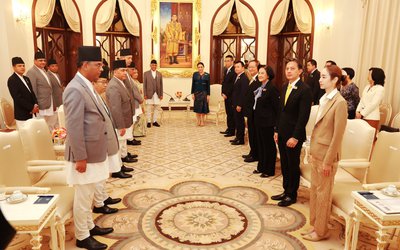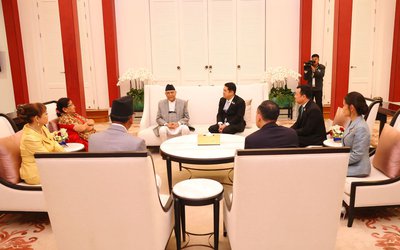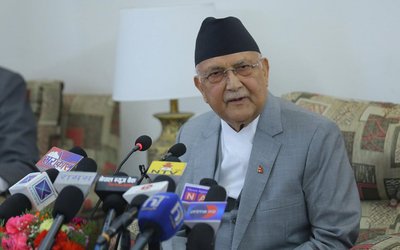More on News





Nepal has completed the draft of the National Adaptation Program of Action (NAPA) and sent it for public discussions. NAPA program director PURUSHOTTAM GHIMIRE, who is also the chief of the Environment Division in the Ministry of Environment, spoke to New Spotlight about various aspects of the program.
What is the aim of NAPA?
Nepal’s development goals, and therefore the NAPA Framework, are set under the overriding aim to reduce poverty in the country.
What is NAPA for?
NAPA are a means of prioritizing urgent and immediate adaptation actions. In Nepal, given the adaptation needs and frameworks the NAPA emphasis on urgent and immediate adaptation needs is important. In addition, with donor agency support to what has become known as the ‘expanded NAPA’, the Ministry of Environment - the Government’s climate focal point - has the opportunity to widen the lens of adaptation planning to include programmatic and bottom-up approaches to adaptation, and to find ways whereby integration of strategies for low carbon development and adaptation can precipitate a series of co-benefits and economies of scale.
How did the process work?
Micro-level impacts assessments were undertaken through three transect appraisal exercises during November 2009 in the Western, Central and Eastern regions of Nepal. Over 60 Government and non-government TWG members participated, who then conducted analyses of the outputs of the transects according to both agro-ecological zones and also thematic areas. The outputs of these analyses were combined with the draft stocktaking reports to produce thematic synthesis reports, subsequently summarized into a single “NAPA Summary Report”. A number of other consultation activities were conducted alongside those mentioned above.
How were the priorities set?
The climate adaptation response measures prioritization process was carefully undertaken and was made as consultative as was possible. Multi-criteria analysis was used in a step-wise process that culminated in identifying the most urgent and immediate climate adaptation response measures according to national interests and criteria.
Have you made vulnerability assessment?
The vulnerability assessments and the work of the TWGs gave rise to “long-lists” of adaptation options under each theme. Prioritization of adaptation options for inclusion into the final NAPA document was conducted through a process that involved an examination of the criteria TWGs used to identify adaptation options. These were systematized by the NAPA Team and an aggregated set of criteria that pooled common criteria used by the TWGs was derived and then approved by the TWGs.
What is the role of the ministry?
The Ministry of Environment provided able coordination and oversight of the NAPA preparation project. The United Nations Development Program acted as GEF Implementing Agency and channeled resources from the Least Developed Countries Fund and from bilateral donors including DFID and Danida into the NAPA project.
How do you see the role of donor communities?
The Ministry of Environment would like to acknowledge the support of our development partners to the expanded NAPA process in Nepal including support to climate change knowledge management. The support given by Embassy of Denmark, DFID, GEF and UNDP is very important for us.
You have already drafted the NAPA. What does it mean for Nepal?
Firstly, we want to finalize the NAPA before the end of August. We have already circulated NAPA draft for comments and suggestions to various stakeholders. NAPA has identified a number of projects but 40-50 projects are considered as a priority. Six projects need urgent implementation. We will develop the details of these six projects to get the funds from the Least Developed Country Fund. A country like Nepal is eligible to get 6 million dollars.
How will you implement other projects?
Well. We have also access to Pilot Projects on Climate Resilience (PPCR) fund and it goes to up to 40-50 million dollars. We will prepare the detailed proposals for the rest of the projects implemented under the PPCR. Along with this, we will have also access to other funds like DFID fund for the implementation of LAPA (Local Adaptation Programs of Action) and are also accessing other funds but basically NAPA is our national document.
Will you have adequate resources?
We don’t have problems of funds, but getting the funds through a fast track is the problem. If you look at the priority of NAPA, conservation of the Churia comes on top of the list. The government also considers this project as important. In the coming budget, there will be some specific projects for Churia conservation where the government is also planning to put 200 million rupees. We are also trying to get 8 million Euro from the European Commission. We discussed with the Ministry of Finance to put same amount of money. According to an estimate, the Churia project will cost about 1 billion rupees. These are the major outcomes of the NAPA project.
Is there a sense of ownership among all stakeholders?
Yes, we take complete ownership of the project. Thanks to the intensive participation of the common people as well as various line ministries, everyone sees NAPA is a draft of the country. The Minister for Environment was the focal point minister, but the team as a whole discharged the responsibility.
How do you see your role as the National Project Director?
It was very easy for me to play the coordinator role as I am also the National Project Director of Pilot Projects on Climate Resilience (PPCR). Under this we supposed to secure 40 to 50 million from GIF Fund. So I am the project director of both the projects. So, it is very easy to implement them. We are developing capacity and institutional set ups at the ministry level. We have six thematic groups like Agriculture and Food Security, Forestry and Bio-diversity, Health, Climate Induced Disaster, Urban settlement. These are the ministries directly involved. Other issues are social inclusion and gender. These are cross cutting issues. We are coordinating the NAPA project but there were six to seven ministries involved from behind in the process. Ultimately, the Ministry of Environment is not going to implement the projects. However, the projects will be implemented by the line ministries. Our role is to coordinate, facilitate and negotiate with the donors. When we get the funds, we will hand them over to line ministries to implement them.
Why is NAPA important?
This is the main document and every donor asks us about it. Without NAPA, you don’t have anything. What is all about NAPA? What are our urgent needs? NAPA is a document which can prove how climate change is affecting the people.
Why was the process of preparation of NAPA delayed?
I came to the ministry just three years ago as a joint secretary. I started the projects. I don’t want to blame anybody for the delay. Not only NAPA, I have been involved in a number of projects related to climate change. Future is bright.






